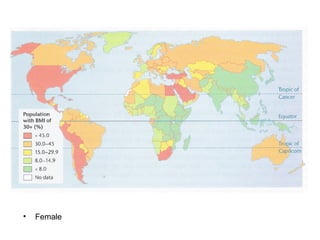OBESITY
- 1. Obesity -Definition Abnormal or excessive fat accumulation that may impair health.
- 2. Statistics According to the World Health Organization, in 2005 1.6 billion adults were overweight 400 million people worldwide were clinically obese. By 2015, that number is estimated to surge to 700 million. At least 2 million children <5 years old were overweight 35% children are overweight in the USA
- 4. What does this show about obesity?
- 5. • male
- 6. • Female
- 7. Measuring Obesity - BMI (Body Mass Index) Weight (kg)2 Height (m) Populations (Asia) that risk of chronic disease increases with BMI >22
- 8. BMI Less than 20 — Under Weight BMI 20-25 — Normal Weight BMI 25-30 — Over Weight BMI 30-40 — Obese BMI Over 40 — Severely Obese The spread from 20-25 shows that what is normal covers quite a big range. This is because ‘normal’ weight for height covers both men and women, and people of different shapes and body composition. A man would normally be expected to have a higher BMI than a woman of the same height, because men tend to have more muscle than women (women naturally have more fat) and muscle weighs more per square inch than fat. For the same reason a slim, muscular woman will have a higher BMI (i.e. weigh more) than a slim, not very muscular woman of the same height.
- 12. Why is obesity increasing? 1. A global shift in diet towards increased intake of energy-dense foods that are high in fat and sugars but low in vitamins, minerals and other micronutrients. 2. A trend towards decreased physical activity due to the increasingly sedentary nature of many forms of work, changing modes of transportation, and increasing urbanization.
- 19. What are the Health Consequences? Cardiovascular disease (heart attack, stroke) Diabetes Musculoskeletal disorders (esp. osteoarthritis) Some cancers (endometrial, breast, colon) Life expectancy reduced by 14 yrs for obese smokers compare to normal weight non smokers! Life expectancy reduced by up to 9 years.
- 20. • The overall cost of obesity to the NHS is currently around £1bn, with a further £2.3bn to £2.6bn for the economy as a whole. • Professor Colin Waine, chairman of the National Obesity Forum, said the figures revealed a "public health timebomb". • "This is serious news because obesity in adolescence is associated with the premature onset of Type 2 diabetes and cardiovascular diseases. • "It really augurs very badly for the future health of the population as these children move from adolescence to adulthood. • "This will have a significant impact on longevity and we are in danger of raising a generation of people who have a shorter life expectancy than their parents.
- 26. More in demand… • Triple width coffins (up to 300kg)!! • Airlines recalculating payload weight • New reinforced hospital beds by NHS
- 27. How can the burden of overweight and obesity be reduced? • At the individual level, people can: • achieve energy balance and a healthy weight; • limit energy intake from total fats and shift fat consumption away from saturated fats to unsaturated fats; • increase consumption of fruit and vegetables, as well as legumes, whole grains and nuts; • limit the intake of sugars; and • increase physical activity - at least 30 minutes of regular, moderate-intensity activity on most days. More activity may be required for weight control.
- 28. Website: Link
- 36. Low and Middle Income Countries
- 40. Obesity A global health issue
- 41. What is obesity? • Obesity is abnormal or excessive fat accumulation that can impair health • Obesity exists when a person has a body mass index (BMI) of 30 or more • It is considered a medical condition in most of the world, but in 2013 the American Medical Association reclassified obesity as a disease BMI is a function of both weight and height
- 42. Impacts on health •Obesity is important because it has significant health impacts: •It increases the risk of developing non- communicable diseases •It reduces life expectancy •It has a economic consequences for health provision as the costs of managing obesity rise
- 43. Global patterns • Obesity varies between countries, from 3.5% of men overweight/obese in Eritrea in 2010 to 97% on the Pacific island of Nauru. • However, in almost every type of country and region it is rising (see table). • In some countries, such as China, the increase in overweight/obesity is startling in a short time frame. • In others, such as the USA, UK and Mexico prevalence rates are very high. % males overweight/obese (WHO data) 2002 2005 2010 Afghanistan 11.2 12.7 15.6 Argentina 70.1 73.1 77.7 Australia 69.7 72.1 75.7 Bangladesh 5.9 6.7 8.4 China 27.5 33.1 45 Ethiopia 7.4 7.8 8.6 UK 62.5 65.7 67.8 Haiti 13 15.1 19 India 15 16.8 20.1 Kenya 6.5 6.9 7.7 Mexico 64.6 68.4 73.6 USA 72.2 75.6 80.5
- 44. Global patterns • Obesity is highest in North America, North Africa and the Middle East, and many Pacific islands. • South Africa and Venezuela are also ‘hotspots’. • Levels in Europe and Latin America are similar — despite differences in levels of development. • As might be expected, sub-Saharan Africa and Asia have the lowest prevalence, although some of the fastest growth rates.
- 46. Development level and obesity • Although there is some evidence of a ‘North–South divide’ in obesity, the pattern is complex. • As the scattergraph shows, wealthy countries such as the Netherlands, Canada and the USA have different levels of overweight/obese males. • Lower-income countries such as Egypt, Samoa and Mexico have levels equal to or even higher than those in developed countries.
- 47. Explanations •Explanations of obesity are complex: •On many Pacific islands the abandonment of traditional farming and fishing has given way to a reliance on imported processed meat. Girth is seen as a signof social and economic status. •In Europe and North America, a high-fat, processed and fast-food diet has combined with increasingly sedentary office jobs and lifestyles. •In much of developing Asia and Latin America the nutrition transition and rural–urban migration have combined to increase fat, sugar and protein in diets at the expense of cereals and vegetable fibre. In cities people labour at desks and workstations rather than in the fields. •In the Middle East oil-rich states, wealthy people have domestic servants so do very little in the way of household chores. Increased car use Fast food Larger portions Cultural appreciation of plumpness Sedentary lifestyles TV and video games Urbanisation Decline in farm employment Processed food Poor education Food marketing
- 48. The ‘globesity’ crisis • The World Health Organization (WHO) has referred to a ‘global obesity epidemic’ and the world’s media to a‘globesity crisis’ • The crisis is worst in middle-income developing countries, like Mexico • Obesity levels are high but so are infectious diseases • This is a ‘doubleburden’ on the healthcare system. • Obesity was recognised as a global epidemic by the WHO in 1997. • Over 1.5 billion people worldwide are currently overweight and 500 million are obese. • The WHO projects that by 2015, 2.3 billion adults will be overweight and more than 700 million will be obese. • About 60% of obese people are women and 40% are men.
Editor's Notes
- AQA + OCR?
- AQA + OCR?
















































